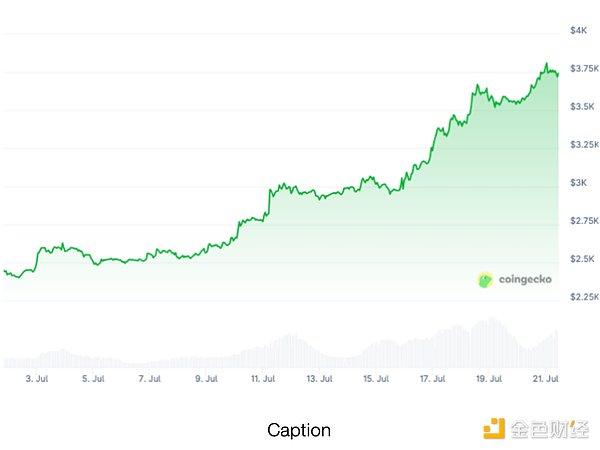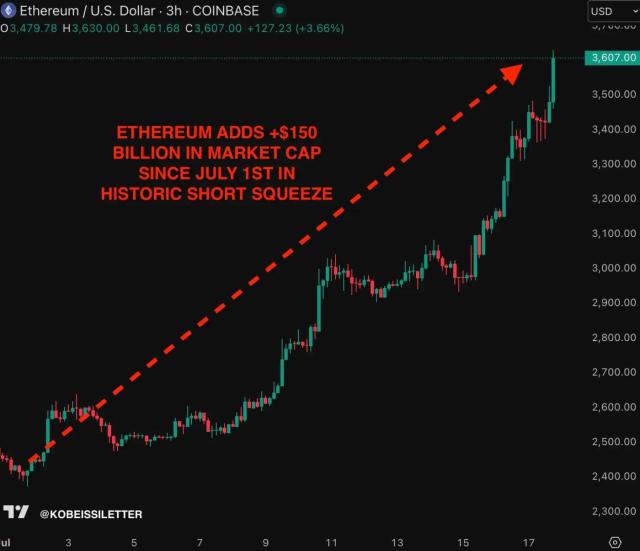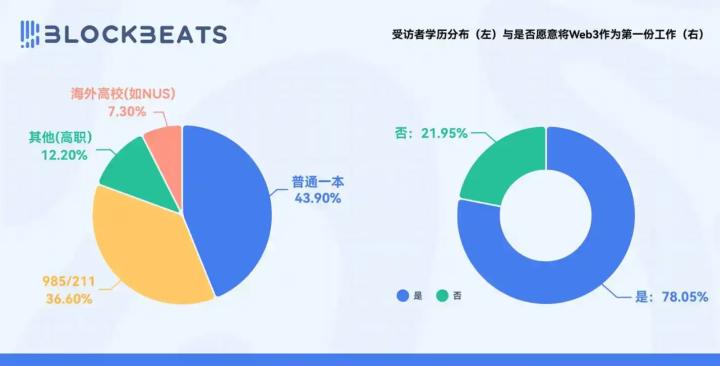On July 30, 2025, Ethereum will celebrate its tenth anniversary. After ten years of ups and downs, what major events have occurred in Ethereum's development history? With Ethereum's current promising price trend, who is buying in? What new narratives does Ethereum have? Can it break through the $4,000 mark?
I. Review of Major Events in Ethereum's Ten-Year Journey
In 2013, Vitalik Buterin conceived Ethereum. In 2014, he began developing Ethereum with Gavin Wood, Charles Hoskinson, Anthony Di Iorio, and Joseph Lubin, and conducted crowdfunding. Ethereum officially went online on July 30, 2015. Today, Ethereum is about to celebrate its tenth birthday. Let's review the major events in Ethereum's development history and look back on its highlights.
In 2013, Vitalik Buterin published the Ethereum white paper. In the white paper, Vitalik acknowledged the birth of Bitcoin in 2009 as a significant breakthrough by Satoshi Nakamoto. However, Vitalik truly wanted to expand the underlying blockchain technology as a tool for distributed consensus.
From July 22 to September 2, 2014, Ethereum began selling, and people could purchase Ethereum using Bitcoin. In the Ethereum announcement, Ethereum was priced at 2,000 ETH per BTC, linearly decreasing to 1,337 ETH per BTC over 42 days. This meant the issuance price of ETH was $0.29 per ETH. However, when ETH first traded on August 7, 2015, its trading price was $2.77.
On July 30, 2015, Ethereum's first version, Frontier, officially went online, marking the official launch of the Ethereum mainnet. The Ethereum network officially moved from theory to practice, allowing developers to mine Ethereum and begin developing dApps and various tools, taking a crucial first step in developing the Ethereum ecosystem.
[The rest of the translation follows the same professional and accurate approach]
On July 19, the "whale/institution accumulating ETH through FalconX" continued to accumulate 19,550 ETH (approximately $70.7 million). Since July 12, this address has continuously accumulated 122,000 ETH (approximately $435 million) through FalconX, with an average price of around $3,213.
2. Institutions
On July 18, Nasdaq-listed Bit Digital (stock code: BTBT) announced the purchase of approximately 19,683 ETH using the net proceeds from a recently completed $67.3 million private placement. After this transaction, Bit Digital's total Ethereum holdings reached approximately 120,306.
On July 18, Trump family crypto project WLFI spent 3 million USDC to acquire 861 ETH.
On July 18, Nasdaq-listed Thumzup Media Corporation announced that its board of directors has approved authorization for the company to invest $250 million in cryptocurrencies, currently planning to invest in BTC, ETH, SOL, XRP, DOGE, LTC, and USDC to diversify its crypto portfolio.
On July 18, SharpLink further acquired 18,712 ETH, with a total of 326,074 ETH, valued at $1.14 billion.
On July 17, BlackRock purchased an additional 158,875 ETH, valued at approximately $574 million. This is a cumulative purchase of 363,445 ETH within two days, with a total value of $1.31 billion. Currently, BlackRock's total ETH holdings have reached 2.46 million, valued at approximately $8.9 billion.
On July 17, GameSquare Holdings announced plans to issue 46,666,667 common shares to raise $70 million, with the company planning to use these funds to enhance its ETH holdings.
III. What Are the New Narratives for ETH?
1. Treasury Enterprises
More and more companies are accumulating cryptocurrencies, emulating Strategy and transforming into crypto treasury enterprises.
On May 27, 2025, sports betting operator SharpLink Gaming, Inc. (Nasdaq code: SBET) announced the signing of a securities purchase agreement for a $425 million PIPE, planning to issue approximately 69.1 million common shares (or equivalent securities) at $6.15 per share (company management team at $6.72 per share). SharpLink will use the raised funds to purchase Ethereum (ETH) as the company's primary treasury reserve asset. After the transaction, Ethereum co-founder and ConsenSys founder and CEO Joseph Lubin will serve as SharpLink's board chairman and strategic advisor to help the company develop its core business. From this point, SharpLink officially becomes an Ethereum treasury enterprise, known as the "ETH version of MicroStrategy".
2. Ethereum ETF
Since the US SEC officially approved the Ethereum spot ETF in July 2024, products represented by BlackRock (ETHA), Fidelity (FETH), and Grayscale (ETHE) have quickly become fund favorites. BlackRock's ETHA leads with $21 billion in AUM, with a daily average net inflow of over $120 million. This scale growth not only reflects traditional institutions' recognition of ETH but also gradually transforms ETH from a "high-risk crypto asset" to a "mainstream allocation target".
The popularity of Ethereum ETFs has significantly changed ETH's holding structure - institutional holdings increased from 12% in 2024 to 27% in 2025, while exchange liquidity dropped from 31% to 18%, a new low since 2018. This "de-exchange" trend reduces short-term selling pressure, reducing ETH's 30-day annualized volatility from 65% to 42%, closer to traditional assets (such as gold's volatility of around 15%), further attracting risk-averse funds. ETH is integrating into the traditional financial system.
3. Sovereign Wealth Funds
On June 4, ConsenSys CEO and Ethereum co-founder Joe Lubin revealed that the company is negotiating with a sovereign wealth fund and bank of a "major country" about building infrastructure in the Ethereum ecosystem. Lubin predicts that Ethereum will usher in a decentralized super cycle and may become the core of a new global financial system.
Vitalik Buterin stated that Ethereum blockchain capabilities will improve 10-fold within the next year. Lubin called Ethereum the "gold standard of trust" and believes its value may ultimately exceed Bitcoin.
4. Reserve Asset of the New Digital Dollar Economy
The development of USD stablecoins has created unprecedented opportunities for Ethereum. Stablecoins provide a channel for global individuals to access dollars - growing 60 times since 2020, exceeding $200 billion - millions of new dollar holders need more than just digital cash. They need returns, investment opportunities, and financial services. Due to regulatory and infrastructure limitations, traditional finance cannot serve this vast new market.
IV. Will ETH Approach $4,000? Is the Altcoin Season Coming?
Ethereum's strong price trend has become one of the highlights of the cryptocurrency market in July. Kobeissi noted: "Since July 1, Ethereum's market cap has increased by $150 billion, while the net short exposure recently hit a historical high."

"Moreover, many shorts are using leverage, which further increases pressure. Ethereum may soon reach $4,000." If Ethereum rises another 10%, an additional $1 billion in short positions will be liquidated.

On July 20, LD Capital founder Yi Lihua wrote: "ETH broke $3,700. The weakness of previous years made everyone forget the bull markets of 2017 and 2020, ETH's ability to far outperform BTC. This round, our insistence that ETH continues to outperform BTC has been verified. Don't short in a bull market, at least hold ETH, and you won't miss this market."
QCP Capital's market weekly report on July 21 stated that multiple altcoin season indicators have exceeded 50, reaching the highest level since December last year. Additionally, ETH perpetual contract open interest jumped from $18 billion to $28 billion within a week, signaling the potential start of the altcoin season. QCP noted that institutional investors are the leaders of this cycle, benefiting from the GENIUS Act's stablecoin regulatory framework, with enterprises beginning to accumulate ETH, SOL, XRP, and ADA and other L1 chain tokens, similar to BTC's role in Strategy and Metaplanet financial configurations.
If ETH receives SEC approval for its staking spot ETF in the coming months, it may attract funds from the BTC ETF, further releasing potential returns. In fact, ETH spot ETF daily net inflows have exceeded BTC for two consecutive days last week, showing surging institutional interest in ETH, with BlackRock also confident in its staking ETH ETF.
Furthermore, the ETH options market shows active bullish spread trading, with significant bullish spread positions established for September and December expirations, highlighting market optimism for the fourth quarter. Currently, BTC market dominance has dropped from 64% to 60%, while ETH's market share has risen from 9.7% to 11.6%. If this trend continues, a new altcoin season may have begun. QCP stated it will continue to monitor related signals and update developments in real-time.
Click to Learn About BlockBeats Job Openings
Welcome to Join BlockBeats Official Community:
Telegram Subscription Group: https://t.me/theblockbeats
Telegram Discussion Group: https://t.me/BlockBeats_App
Twitter Official Account: https://twitter.com/BlockBeatsAsia







